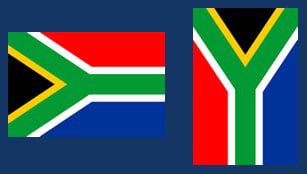I really don’t know how I feel about this. In the lead up to the World Cup, South African flags became all the rage. Before, you would only see them on government and other official type buildings and spaces. Just before, the flag was on cars, in windows, on t-shirts, etc. It did feel a bit strange but it was heartening to see a certain pride being taken in nationhood.
Sadly, as we journeyed deeper into the tournament – and after Bafana Bafana was knocked out – the flags seemed to become fewer and fewer, particularly on cars. Now. With the World Cup only a few days behind us, I have not seen as many cars sporting the South African flag which, in a way, is sad. I do think one can take pride in where they are from without it being a popularity contest, a “who is better than who”. I don’t think one should wait for an event like the World Cup to celebrate what one feels is positive about their country.
For those who do not see the reason for “waving the flag” any longer, Nashua Mobile have modified their “Fly The Flag For South Africa” campaign to a “Donate A Flag” campaign: “South Africans can now donate their flags to charity by simply popping in at any Nashua Mobile store and dropping it in the dedicated bins in each store. These flags will be given to regional charities to be repurposed and sown into useful items such a duvet covers, pillow cases and curtains.”

Liezel van der Westhuizen, Idols presenter, donating her South African flag to charity as part of Nashua Mobile’s Donate a Flag Campaign.
While it sounds like a worthy cause, creating necessary items for those in need, I was initially concerned as to whether they had taken into consideration the guide for using the South African flag as compiled by The Southern African Vexillological Association (SAVA) – Vexillology is the study of flags in all their shapes, sizes and forms.
I chatted to the Nashua Mobile people and it seems they have: “Nashua Mobile has a deep respect for our country’s national symbols. We will treat our flag with the consideration it deserves throughout this project and will be guided by the regulations regarding the flying of the national flag, which were published in 1994. We have also submitted samples of pillow cases and duvet covers to the DTI for approval before we make them available to the selected beneficiaries.”
See below for the guidelines:
Treat your flag with respect
The National Flag must at all times be treated with dignity and respect. In the Regulations Regarding the Flying of the National Flag, published just before the flag was adopted in 1994, the dos and don’ts are clearly spelled out.
The flag must never:
- Be allowed to touch the ground or floor.
- Be used as a table cloth, or draped in front of a platform.
- Be used to cover a statue, plaque corner stone etc. at unveiling or similar ceremonies.
- Be used to start or finish any competition, race or similar event.
- Be manufactured or used as underclothes, bath and floor mats or any similar demeaning application.
- Be used for any commercial advertising in a manner that will distort or show disrespect to the flag.
Use of the flag in artefacts and products is subject to the approval of The Presidency and, in the case of manufactured items, theDepartment of Trade and Industry.
Traditional rules for handling the flag
There are a number of traditional rules of respect that should be observed when handling or displaying the National Flag:
- The flag should always be hoisted at the start of the working day and lowered again before or at sunset. It is not to remain flying at night unless suitably illuminated. In South Africa, this rule still applies to government-designated flag stations, while through common usage the flag can be displayed 24 hours a day outside of official stations.
- The flag should be hoisted briskly and lowered ceremoniously.
- Whenever a person sees an official flag hoisting or lowering ceremony in progress, he or she should come to a halt and stand respectfully to attention for the duration. If a hat is worn, it should be removed and the right hand should be placed over the heart in salute. Persons in uniform should salute in the manner prescribed by their service. (The same rules apply when the National Anthem is being played or sung.)
- The flag should never be depicted, displayed or flown upside down. Flying a flag upside down is the traditional sign of surrender! When displayed horizontally, the black triangle should be to your left and the red band uppermost.

- When draped vertically, a flag should not merely be rotated through 90 degrees, but also reversed. In the case of the South African flag, the black triangle must be uppermost and the red band to your left. (One “reads” a flag like the pages of a book – from top to bottom and from left to right – and after rotation the results should be the same.)
- It is also insulting to display the flag in a frayed or dirty state. The same rule applies to the flagpoles and halyards used to hoist the flag – they should always be in a proper state of maintenance.
- The flag may never be defaced by placing slogans or any writing or design directly on the field of the flag.
